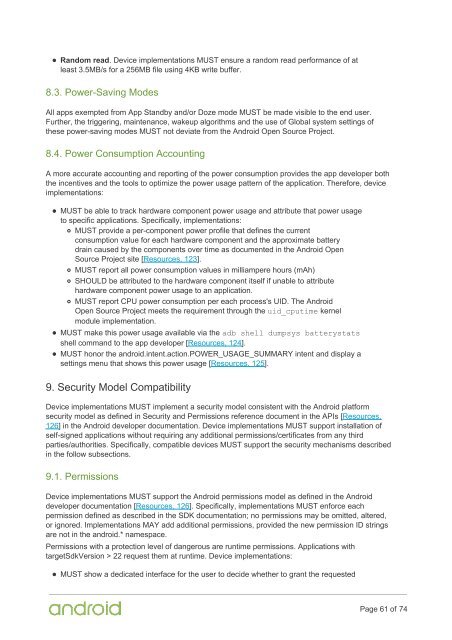Compatibility Definition
2f44OdUf0
2f44OdUf0
Create successful ePaper yourself
Turn your PDF publications into a flip-book with our unique Google optimized e-Paper software.
Random read. Device implementations MUST ensure a random read performance of at<br />
least 3.5MB/s for a 256MB file using 4KB write buffer.<br />
8.3. Power-Saving Modes<br />
All apps exempted from App Standby and/or Doze mode MUST be made visible to the end user.<br />
Further, the triggering, maintenance, wakeup algorithms and the use of Global system settings of<br />
these power-saving modes MUST not deviate from the Android Open Source Project.<br />
8.4. Power Consumption Accounting<br />
A more accurate accounting and reporting of the power consumption provides the app developer both<br />
the incentives and the tools to optimize the power usage pattern of the application. Therefore, device<br />
implementations:<br />
MUST be able to track hardware component power usage and attribute that power usage<br />
to specific applications. Specifically, implementations:<br />
MUST provide a per-component power profile that defines the current<br />
consumption value for each hardware component and the approximate battery<br />
drain caused by the components over time as documented in the Android Open<br />
Source Project site [Resources, 123].<br />
MUST report all power consumption values in milliampere hours (mAh)<br />
SHOULD be attributed to the hardware component itself if unable to attribute<br />
hardware component power usage to an application.<br />
MUST report CPU power consumption per each process's UID. The Android<br />
Open Source Project meets the requirement through the uid_cputime kernel<br />
module implementation.<br />
MUST make this power usage available via the adb shell dumpsys batterystats<br />
shell command to the app developer [Resources, 124].<br />
MUST honor the android.intent.action.POWER_USAGE_SUMMARY intent and display a<br />
settings menu that shows this power usage [Resources, 125].<br />
9. Security Model <strong>Compatibility</strong><br />
Device implementations MUST implement a security model consistent with the Android platform<br />
security model as defined in Security and Permissions reference document in the APIs [Resources,<br />
126] in the Android developer documentation. Device implementations MUST support installation of<br />
self-signed applications without requiring any additional permissions/certificates from any third<br />
parties/authorities. Specifically, compatible devices MUST support the security mechanisms described<br />
in the follow subsections.<br />
9.1. Permissions<br />
Device implementations MUST support the Android permissions model as defined in the Android<br />
developer documentation [Resources, 126]. Specifically, implementations MUST enforce each<br />
permission defined as described in the SDK documentation; no permissions may be omitted, altered,<br />
or ignored. Implementations MAY add additional permissions, provided the new permission ID strings<br />
are not in the android.* namespace.<br />
Permissions with a protection level of dangerous are runtime permissions. Applications with<br />
targetSdkVersion > 22 request them at runtime. Device implementations:<br />
MUST show a dedicated interface for the user to decide whether to grant the requested<br />
Page 61 of 74


